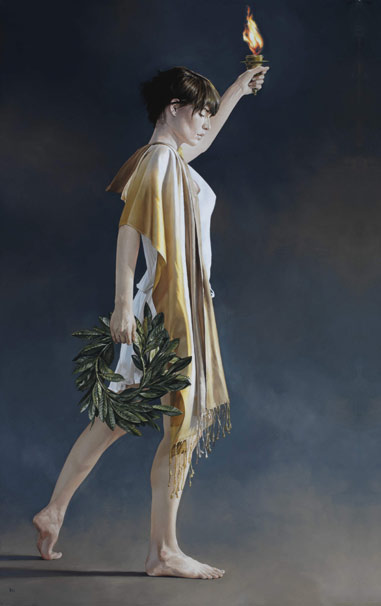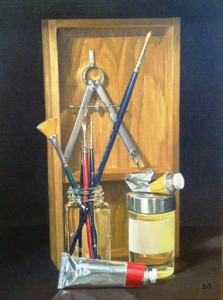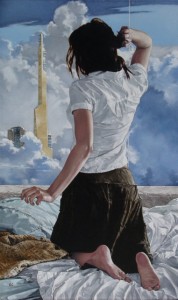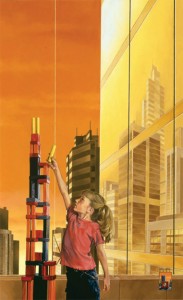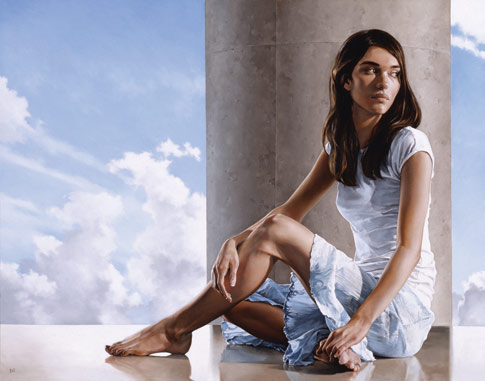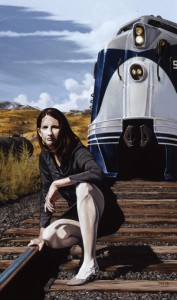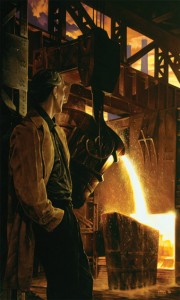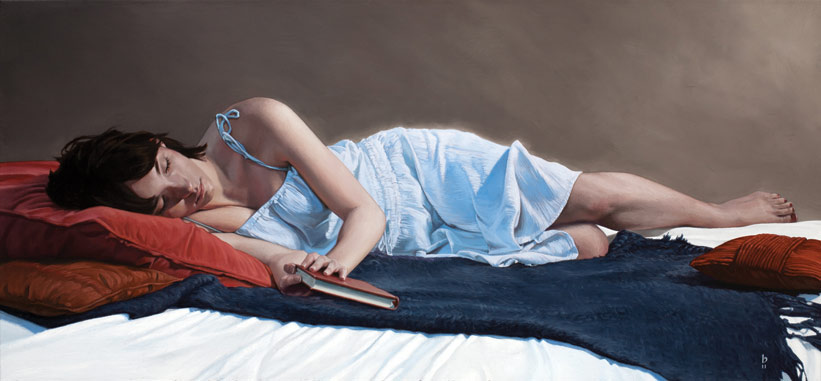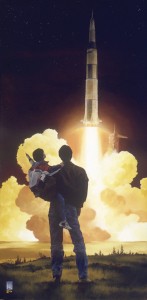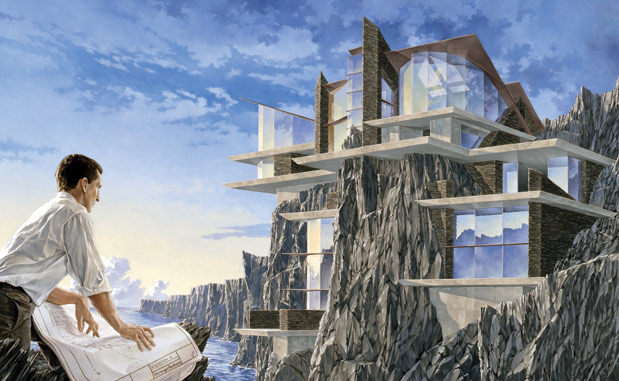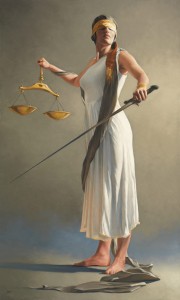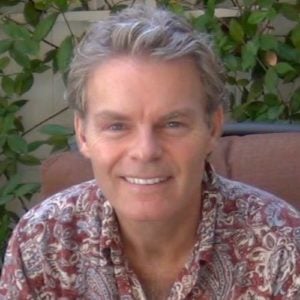Craig Biddle: Thank you for joining me, Bryan.
Bryan Larsen: My pleasure.
CB: Many of our readers are already fans of your work, others are likely to become fans over time, and I suspect all will enjoy hearing about how you create such beautiful paintings, what inspires you, and how you became an artist.
Let’s begin with this last point: How did you get into art? And why did you choose painting as a career?
BL: I’ve been drawing and painting since before I can remember. My parents were very supportive of that, so I got a lot of practice and encouragement, and I had a ready supply of paper, crayons, and pencils.
As far as painting for a living, I went to college on an illustration scholarship, but I never really thought I would do it for a living. I always assumed it would be an auxiliary to whatever my line of work was. I didn’t think you could make a living as an artist. I’m glad I turned out to be wrong.
I chose painting over some of the other mediums because it offers a lot of flexibility and a lot of permanence. You have access to a broad range of colors and techniques; it’s more affordable than many of the other mediums; it’s easy to make reproductions of. I think it’s something a lot of artists gravitate to because it’s simple and inexpensive from the production side.
CB: Perhaps it’s simple for someone with your skill! And I gather, given the scholarship for illustration, that you had acquired substantial skill even prior to college. Tell me about your schooling and how you transitioned to painting for a living.
BL: Well, it gets a little complicated there. I was good at art in high school, and Utah has what it calls a Sterling Scholar program—it’s a statewide competition for scholarships in various disciplines.
My art teacher encouraged me to enter that, and I ended up getting a scholarship to an illustration program at a state college in Utah. It was a pretty decent program. The complication arose when the instructor I really liked, the one who seemed to really know what he was doing, retired, and simultaneously I ran out of money.
So I left the program, moved back to Salt Lake City, and started working as a cabinetmaker. My dad was always into woodworking, so I knew a bit about it. And then I got married and worked while my wife went to school.
My other love, while I was in school, was mathematics and design. So when my wife finished school, I went back to be a mechanical engineer. I always thought that would be fun. So I had two years of illustration education and then the rest of my college was in engineering.
About three years into that program, I was painting in my spare time, and I sold my first painting. I had never really considered fine art as a career option before that, but the sale opened up the possibility, and I decided to take a stab at it.
It was a rocky start, but in retrospect I had it pretty easy. The Cordair gallery was willing to take my work, even though I didn’t have a large portfolio, a degree, or any real references. My boss at the cabinet shop was also supportive. I must have quit four or five times to paint full-time, and when money got tight he was always willing to let me come back. It certainly didn’t hurt that my wife was working, too. Eventually art sales picked up, and I was able to reach that tipping point where I was consistently making as much painting as I had been at the shop. I never looked back.
CB: Have you ever worked in other mediums or art forms, such as sculpture or music?
BL: My mom was a piano teacher, and I played the piano. But I don’t think my understanding of music runs deep enough to create music.
I do enjoy sculpture quite a bit. But I think complicated themes are more difficult to tackle in sculpture. You only have a few things to work with—the gesture, the figure, and maybe the interaction between figures. You don’t have the benefit of using backgrounds, different color schemes, or different times of day to support the composition like you do with paint.
Sculpture is also very expensive on the start-up side. Even if you work in clay, you have to be able to pay to have the casts made. I didn’t have the option of doing that at the beginning. I did a lot of sculpture in high school and college, but when I was doing art on my own, in my spare time before I started selling paintings, there was no way I could afford to pursue it.
You have to have space, too. You have to be able to make noise. So in some ways I moved into painting because it was so simple on the production side—although I find it interesting that a lot of the things I’m drawing and painting these days seem like themes that are simple and figurative and could work well as sculptures.
Maybe, one of these days, when I have the time, I’ll go back to sculpture. I think it’s beautiful; a lot of my favorite artists are sculptors.
CB: You’ve done some still-lifes, for instance The Art of Precision, and some cityscapes, such as a couple in the series “Among the Clouds,” but you focus primarily on painting human figures in various contexts and environments. Why is this?
BL: I think even with still-lifes and cityscapes and landscapes, the thing that interests me—in both the things that I do and other artists’ work—is the human element.
The reason I would do a cityscape instead of a landscape would be the human creativity and design and intelligence behind the city. I find that interesting. The same with the still-lifes I have done—the objects in The Art of Precision are the tools of a creative human mind; they’re not just objects.
The still-lifes and the landscapes I’ve done are sort of paintings of people; it’s just that the people aren’t in the paintings. And I guess I just find it easier to identify with images of people. I find them fascinating and beautiful, and it’s what I’ve been drawn to all along.
There are a lot of amazing still-life and landscape painters. When I do them, they tend to be more scholastic. I’m learning to paint them so that they can be backgrounds or backdrops for figures.
The simplest answer, though, is that I find the people, the figures, more interesting and more telling. They’re more difficult and more challenging to paint as well—and I like that aspect.
CB: Who are some of your favorite painters and why?
BL: That’s a big question. I guess it depends on the genre.
As far as figure painters are concerned, William-Adolphe Bouguereau is an amazing figure painter. I like him mostly for his technique. His subjects weren’t always the most compelling, but they were always beautiful. I think there are very few people who would argue that he wasn’t one of the best, if not the best, figure painter who ever lived. He was certainly the most prolific. If I were ever to aspire to someone’s technique in painting a figure, it’d probably be his.
Alma-Tadema is another Victorian painter. What I like about him is his attention to detail. He painted amazing scenes of Roman baths and people looking over vistas at huge, man-made edifices of marble or down at ships. The figures are beautiful. So I admire that attention to detail and his work ethic—he was prolific.
There’s a story about him that I love. When he was starting out, a critic said that his marble looked like blue cheese, and, instead of being offended by that, he took it to heart. And he ended up working like crazy on painting marble. From then on, almost every painting he painted had marble in it, and these days he’s renowned for being one of the best painters of marble who ever lived. I admire that ability to take criticism and turn it into a strength.
CB: A new twist on the “when life gives you lemons” cliché . . .
BL: Yes, when life gives you lemons, you build a giant lemonade empire . . .
CB: And when life gives you blue cheese, you learn how to paint marble perfectly.
BL: Yes, I love that. I also love that he wasn’t concerned with painting what the critics thought was popular. He was a Victorian painter, but toward the end of the Victorian era the impressionists started to take hold, and critics started to like what they were doing. But he painted what he liked and was popular with a lot of regular people. I think this is important because he was painting things that mattered to people other than just art critics. And I like that about him.
CB: So do I, being a regular person.
BL: Yes. If you can understand it and it looks like something you think is beautiful and worth aspiring to, that’s what I like. And he was good at that.
As far as other painters who did figures, there’s a gentleman named Jacob Collins who works in New York. Like Bouguereau, his subject matter isn’t always the most exciting. He paints a lot of what you would call academic or academy-style paintings that are nudes reclining—not really the most interesting settings or subjects, but, again, incredibly beautiful.
The reason I like him is because he’s an absolute master at painting the figure and he’s one of the artists who has decided it’s his mission to bring back that kind of classical skill or technical ability—that attention to detail—which has really been lost for a long time.
Although he doesn’t paint many interesting subjects himself, he has done all the work to figure out how to do it, how to paint in that kind of amazing, realistic, representational style. And, like I said, he’s dedicated his career to rediscovering those techniques, adding to it as best he can using modern understanding of light and color, and then passing that on to his students—some of whom I think will end up painting really amazing paintings. I think he’s great.
Other inspirations include Maxfield Parrish. He is sometimes dismissed as an illustrator, but I think his artistic vision and talent are amazing. His paintings were among my favorites when I was a kid. They still are.
There’s also John Burke, who paints really loosely; but I’ve always been a sci-fi fan, and he paints scenes of starships and planets in a way that’s very mysterious and artistic. There’s a part of me that really likes his work, too.
CB: I’ll have to look him up. I’ve never heard of him.
BL: Not a lot of people have, I guess. He was an illustrator. But he was a very talented one, and I think he had a great sense of composition. His scenes are grand and awe-inspiring. His sense of design was amazing—he pulled it off in the style of an old master painter, but painting in the 25th century.
CB: How do you choose subject matter for a painting? What’s your process there?
BL: I’m drawn to a few different things. Human achievement is always something I’m really interested in, especially groundbreaking new ideas that change the way people live. I like working with subjects such as Galileo and Newton, because they were working at a time when science was simpler and a lot of what they did was visual. You could see what they were doing, so it makes for a great composition.
I’d love to do a painting of Turing and his early computer. I have a friend who’s a neuroscientist, and I’m trying to figure out how to turn that into a painting. It’s hard because a lot of the innovation that happens now is stuff that’s subtle and unseeable, and thus it’s hard to make it visually striking.
I’ve always loved architecture. My dad was a draftsman and a huge fan of Frank Lloyd Wright. For as long as I can remember, he had a huge poster of the mile-high skyscraper at his office, and I always loved Wright’s buildings. I also always loved seeing people in environments that they created themselves. I still find that fascinating. I love doing paintings of the human form juxtaposed over the beauty of geometric surroundings they’ve created for themselves.
I’m also really drawn to the concept of aspiring to do what your heroes have done and take it another step beyond. So I’ve done a lot of paintings with children aspiring to do great things. They seem to have the purest form of hero worship. For them, there are no limits; and if something has been done, there’s no reason why you can’t do something twenty times more difficult.
Once I have a subject in mind, it’s just a matter of trying to figure out a way to make it work in a simple composition, finding a model that fits the part and going from there.
CB: So you start out with a theme in mind, then you look for a model and a scene that can convey that?
BL: Most of the time it works that way. For a long time, I would actually do careful drawings trying to work out the exact pose and the interaction between the figure and the background. Eventually I realized that a lot of times the relatively crude sketches I would do beforehand would have problems. I’d try to put a real person into that pose and it looked unnatural. Or, because people’s proportions are different, it was not possible for them. Sometimes there are other issues. The end result is that I would often change the pose entirely once I had the model in front of me.
So these days, I’ll usually have the basic idea and a really rough sketch. Then I’ll find a model who I think fits the idea and then sit down with the model for a few hours and try different poses and interactions, trying to figure out what looks right and feels natural. Then I’ll do sketches based on that.
I’ve also found that a lot of times out of those brainstorming sessions with the models, I’ll stumble across poses that I hadn’t thought of before that suddenly strike me as interesting—or I’ll get an idea while the model is there and try something else. So, especially recently, I have had a few ideas develop simply out of brainstorming sessions. Most of the time the idea comes first, but there are times when a pose suggests something that I hadn’t thought of yet and the painting evolves from there.
CB: One of the things I love about your work is that the subjects in your paintings always look purposeful, even when they’re just sitting or relaxing. For instance, in both The Letter and Deliberation, the woman is sitting and not engaged in any physical activity beyond that, but she’s clearly up to something mentally—she’s clearly, well, as the title of Deliberation says, deliberating. There seems to be something going on in the minds of all your subjects; they appear to be active mentally even if not physically. Do you intentionally portray your subjects this way, always with purpose?
BL: Absolutely. That’s what makes them more interesting to me than landscapes. It’s not just the fact that they’re beautiful people; what’s beautiful to me is their capacity—the things they can do, the things they think, the things they can create, and their appreciation for beauty in others.
To me, it would be less interesting to paint a person doing nothing or thinking nothing—even if they were really beautiful. It would be like painting a beautiful mountainside. It’s beautiful, and there’s value in that, but it’s so much more interesting to have something else going on that’s uniquely human and purposeful and didn’t just happen by accident.
CB: This aspect of your work is obvious in some paintings—for instance, in Young Builder the girl is reaching up to place another block on her skyscraper. In that case, her purpose is clear in the physical action she’s taking. But you accomplish this even in the drawings and paintings where people are not physically acting. You accomplish it in their countenance and body language. How do you go about that? What methods or techniques are involved?
BL: Well, doing a painting as opposed to a photograph accomplishes a little of that, because the details that an artist decides to include in a painting can’t help but reflect what the artist thinks is important.
I know that I have a tendency to pull out geometric and architectural forms and figures rather than drapery, but you mentioned Deliberation, and that kind of ties back into what we were talking about before. That was one of those poses where I had brought in a model for something else completely, and as we were working through some different poses, I caught her in a moment of trying to decide what to do next. That struck me as really interesting. The pose and her facial expression said a lot about what she was thinking.
So when I was looking back through the reference photos I had taken, that one jumped out at me even more than the ones I had taken for the painting I had intended to do. The idea evolved from there.
So that’s a situation where I saw something in the model that hadn’t occurred to me to do before, and it turned into a new painting.
CB: A beautiful one, at that.
BL: Thanks!
CB: You seem also to have a great fondness for people engaging in feats of engineering and production. In addition to Young Builder, several others are in this vein—Motive Force and First Heat come to mind. Tell me about your inspiration here.
BL: I’ve been drawn to engineering and architecture all along. Motive Force and First Heat were, for anyone who has read Ayn Rand, obviously inspired by Hank Rearden and Dagny Taggart. But engineering and the sciences in general inspire me because they’re such obvious examples of physical things that have been brought about only because of what people can dream up and figure out and make work.
To me they are as great an example of human achievement as an athlete; they’re as beautiful as the human figure, so it makes sense to me to mix the two together. And as I mentioned earlier, I like to paint people in the background that they created for themselves rather than paint them wandering through a landscape, no matter how beautiful that is. Man-made environments are more interesting to me.
If I hadn’t been a painter, I would have been a mechanical engineer. I’m amazed by the things that people do in these disciplines, so it makes sense that I think they are important enough to paint.
CB: As happy as I am that you’re a painter, I’m curious as to what you would have created as a mechanical engineer.
BL: [Laughing] I was always interested in outer space, so Elon Musk and SpaceX are things I follow closely—with a tiny bit of jealousy in the “what if I had gone that route” sense.
CB: It’s that one-life problem . . .
BL: Exactly.
CB: Once you’ve selected your subject and you know what you want to paint, how, generally speaking, do you go about creating a painting—what’s involved in the mechanics of the process?
BL: To simplify the whole process: The first thing is to have the idea. Then I need to find a model; sometimes it’s really important to find out who the model is—he or she may have to fit a certain profile. Other times, it doesn’t matter. But I’ll often start with three to twenty photos of the model and a dozen photographs of different backgrounds and textures and things that are going to be in the picture. Then I’ll sit down and do a compositional drawing to scale.
Once I have that, and I think all the proportions are right, I transfer that to the canvas. There are a few ways to do this. For instance, I can use a grid system to manually enlarge the image onto the canvas. Some artists use a projector. These days, I’ve found it’s really handy to have a drawing blown up on a large-scale Xerox machine. I’ll cover the back of the enlarged copy with oil paint, fix it to the canvas and trace over the drawing. It works just like carbon paper.
But one way or another, I’ll transfer that drawing to the canvas, and from there it depends on the composition. If the lighting is really extreme, if the colors are going to be bright and difficult, sometimes I’ll do an underpainting or study to help me figure out the lighting.
Most of the time, once I have the overall composition figured out, I dive right in—referring back and forth to the different pictures and trying to keep a general image in my head of what I want the overall relationships to be.
Again it depends on the complexity of the painting, but if it’s simple I’ll start with a figure, because it’s the most interesting. I usually paint the face first and then all the other flesh tones. If the composition’s very complicated, I’ll start with the background—just to make sure that by the time I get to the figure, I can adjust the colors and the flesh tones to make them work with the background.
So most of the time I’ll work in a one-pass sort of way, painting one thing until it’s finished—a face, an arm, a dress, a building, the sky. Then, when I have everything there, every once in a while there’ll be something that obviously doesn’t fit or needs to be adjusted. I’ll adjust how light or dark it is, or adjust the colors to make them play well together.
CB: And you work exclusively in oil, right?
BL: Yes, it’s my favorite medium. It allows an amazing amount of flexibility for reworking and refining to get things exactly the way you want them, and it can produce an incredible range of colors.
CB: What’s your favorite part of the process?
BL: As I’m working, the entire canvas is sketched out, everything’s there, and I’m dropping these bits and pieces in their finished state, but they exist in a vacuum—just a face floating in space, then an arm—and it can be disconcerting. There’s a lot of second-guessing that goes on there; you have to trust what you know from past paintings and the reference material. But there’s always an enormous sense of justification or relief when you fill in the final bit of blank canvas and the whole thing comes together.
CB: You astonish yourself once again?
BL: Well, if you’ve ever painted a room and you’ve masked everything off with tape and you know all the lines are straight, and the molding is straight, and everything’s perfect, but the tape is all there and you can’t really tell if the paint job is good. As soon as you pull down the masking tape and put in the furniture, it all comes together and works as one unit.
That’s a really gratifying moment with a painting because the month or two months of work that you’ve done finally pay off.
I also enjoy seeing a finished painting again several months after finishing it and sending it off. When I first finish a painting, I have been looking at it far too long to be objective about it. But after a nice break I can appreciate it for what it is. That’s a great feeling.
CB: I’ll bet it is.
I understand you produce commission works as well as speculative pieces. Who are some of your commission clients, if that’s OK to discuss, and what kinds of works have you produced for them?
BL: My biggest client by far has been BB&T, a bank headquartered in Winston-Salem, North Carolina. Until about two years ago, its CEO was John Allison, who many Objectivists will be familiar with.
He’s an amazing person. I met him briefly at a conference one year and was very impressed by him and was quite excited when, through the Cordair gallery, he approached me about using Heroes—the painting of the Apollo rocket launch with the father and son—on the cover of the bank’s annual report.
I was obviously going to say, “Yes,” and that was great. The next year, they used Young Builder. The third year they decided to commission an original painting to use on their annual report. And every year since then, including these past two years, when they’ve had a new CEO, they’ve continued to do that.
That’s been a really fun project every year. They always want something interesting and achievement-oriented, the exact sort of thing I love to paint, and they’ve been very easy to work with. The bank’s corporate symbol over the past few years has been a lighthouse, so I’ve done a lot of seascapes with figures, with a lighthouse prominently featured in the background.
I also did a big commission for an architectural firm called The Durango Partners. That was a really fun commission, too. They wanted me to paint an architect looking across a bay at a newly completed house, which they wanted to be his masterwork. He’s standing with the blueprints draped over a rock in front of him. We ended up calling the piece Breaking Through, in reference to both the career of the architect and the way the house seemed to be breaking out of the cliff face.
The really fun part of that commission was designing the house. I must have done fifty different elevation views before we found something they liked.
I have done a number of simpler portrait commissions and things like that as well.
CB: Where can people see your works—especially those that are for sale?
BL: If they want to see originals, the only place is the Quent Cordair Fine Art gallery in Napa, California, which has a number of my originals as well as prints of paintings that have already sold. They’ve done an amazing job representing me, to the point where I can’t even keep them supplied let alone think about selling things anywhere else.
CB: Nice problem!
BL: It is. It’s a really good problem. They’re amazing people, too. And they have quite a few originals there, as well as prints. Their website is www.Cordair.com. All the originals, as well as anything they offer prints of, are shown on their website.
I also maintain a website of my own at www.bryanlarsenfineart.com. I try to keep that updated. There are links there to a blog where I occasionally post images of paintings in progress or art-related stories that I find interesting. My wife helps me manage that, and she has a great eye for interesting web stories.
Aside from those two online sources and the gallery, you’ll have to stumble on someone who owns a piece.
CB: If someone wants to commission you to do a painting or portrait, how should he contact you?
BL: The best way is to call the Cordair gallery. They’re really great at working out all those details, and then I can concentrate on what I do and not worry about the business side of things.
CB: What are you working on now?
BL: Right now, in fact today, I will probably finish the last few details on a painting of Justice, which I’ve been working on as a sort of companion piece to Liberty (shown above), which I painted a few years ago. I’m pretty excited about it. Images of it should be up at the Cordair website soon.
CB: Well, I look forward to seeing Justice, and I appreciate you taking time to talk to me.
BL: Again, my pleasure.


![[TEST] The Objective Standard](https://test.theobjectivestandard.com/wp-content/uploads/2017/10/logo.png)

